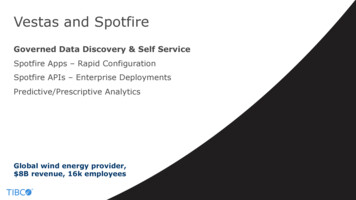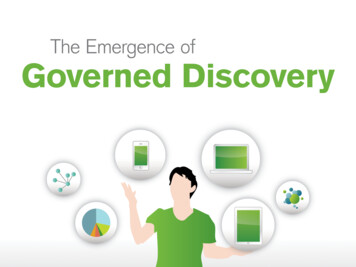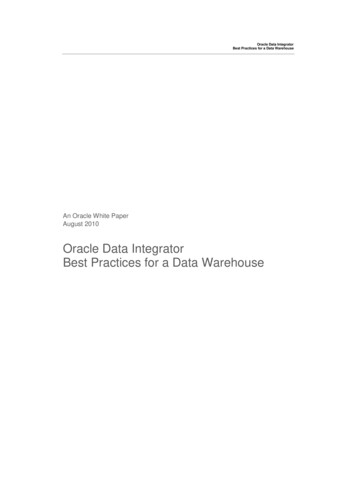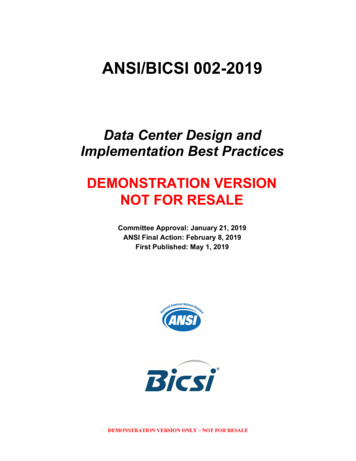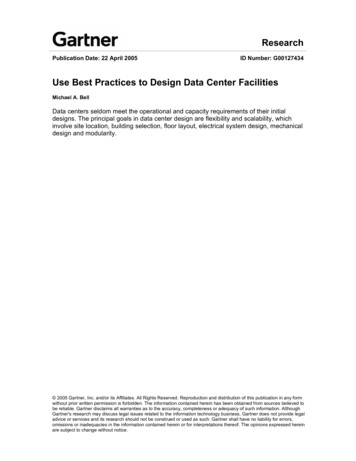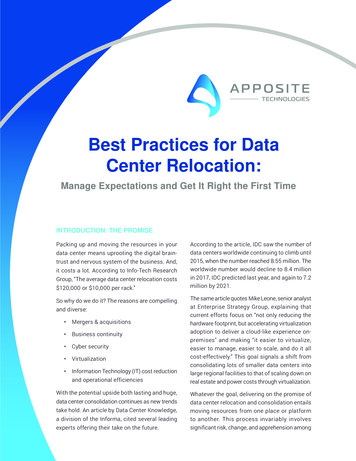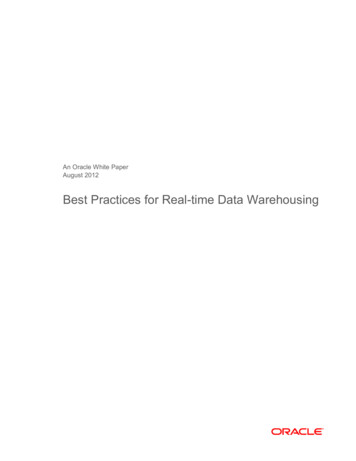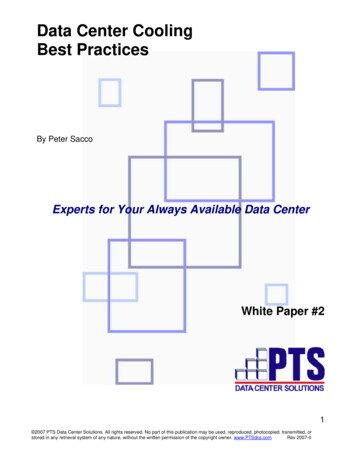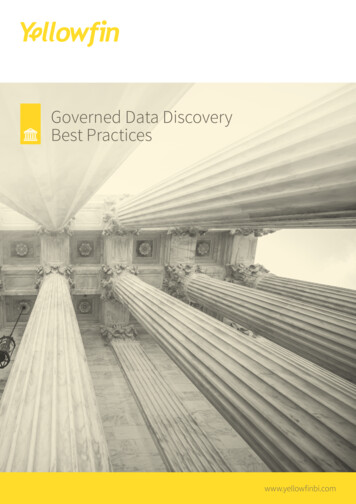
Transcription
Governed Data DiscoveryBest Practiceswww.yellowfinbi.com
The emergence of data discoveryOnce you have been tarred with a brush, it’s a difficult reputation to remove.Tar is sticky.Traditional BI environments have been tarred. Typically, they’ve been all about IT. And they’ve been slowto produce the types of reporting business users want. There was no access to data except through IT,and when you finally received the report you wanted, it was probably too late anyway. So for one-off,quick data deliveries, traditional BI has been seen as pretty useless.According to TDWI’s Best Practice Benchmark Report Organizational and Performance Metrics forBusiness Intelligence Teams 20151, it was taking an average of 5.8 weeks for IT to create a complex reportor dashboard. And for almost a third of organizations, they needed nine weeks or more to add a new datasource to an existing business system. That’s nearly a whole quarter to get one new data source!So, along came self-service data discovery. It handed over the reins of fast data insights to the businessuser. The idea? Less IT involvement for fewer delays. As a business user, you can get the information youwant when you want it and you can determine the data patterns yourself.This sounds great. But what about data security and accuracy?Data discovery without governance“Through 2017, less than 40% of self-service businessintelligence initiatives will be governed sufficiently toprevent inconsistencies that adversely affect the business.”– Gartner, as cited by Dataversity, 20172Ungoverned data discovery creates these issues: Analytical silos with no single source of thetruthIT Issues Difficult to maintainLet’s put that statistic another way: over 60 percent of selfservice BI initiatives are insufficiently secure and trustworthy.Inconsistencies in the data will lead to bad business decisions. Andbad decisions lead to business failure.If lack of data discovery governance can mislead businesses intheir strategic decisions, this is a major issue that needs to betackled.Most pure-play data discovery tools are in-memory, desktopbased applications sold at a departmental level. While they delivermore freedom to end-users, they do not meet the security andgovernance needs that enterprise IT demands. This creates a trustissue. If data is handled while ungoverned, the data cannot betrusted. If the data cannot be trusted, nobody will use it. Then youend up with an organization that is back in the same position as itwas before BI was introduced.Governed Data Discovery Best Practices Lack of security and transparencyBusinessIssues Business gets a subject-oriented view ofinformation Conflicting reports create distrust in data No re-use of data models, business logic ormetrics Difficult to deploy enterprise-wideStrategicIssues Long-term analytical maturity of business isaffected Risk making key business decisions onincorrect data0201
Governed Data Discovery Best PracticesGoverned Data Discovery environments meet the dualdemands of enterprise IT, including analysts, and businessend-users. End users are allowed the freedom and agilityto access and analyze data, while IT has transparence andcontrol over security and governance.How do you achieve governed data discovery? Here are bestpractices for implementing data discovery governance.01 Balance (It’s not just about data discovery)Different users have different needsEach organization has different types of users including analysts or power-users, ITadministrators, and business users who consume BI content. Self-service data discoveryfeatures are helping analysts create content quickly. However, not everyone in theorganization has the desire or knowledge to create content from scratch.More BI consumers than creatorsBusiness users prefer dashboardsIn any organization, there are more business users who consumeBI content than there are analysts who create that content.Looking at statistics of self-service BI adoption, there is no growth.Why is this? According to a TDWI report 3, business users prefer tointeract with data via dashboards rather than self-service datadiscovery.90%of usersconsume content10%of userscreate contentDashboards are intuitive for non-technical business users tomonitor and interact with data. Interactive drills and filters givethem the ability to query the data without needing to createreports from scratch.IT department needs governanceIT administrators need to manage the security and governance ofEnterprise BI. What matters to IT administrators is: Enterprise security Trust in the data Auditability and transparency Controlling users’ permissionsAnalysts want data discovery A semantic layer to ensure consistencyThe agility of self-service data discovery features improves analystproductivity. Analysts want the freedom to quickly connect andvisually analyze data without relying on IT to prepare the data forthem first. A platform to share and collaborateGoverned Data Discovery Best Practices ScalabilityFor business users to trust the data, it must be governed.0301
02 Make Sure it’s SecureGoverned data discovery is about ensuring your BI platform is secure and the data istrustworthy. An insecure BI environment exposes your business to risk. You don’t wantsensitive data, like payroll data, personal medical data and R&D data, exposed or changedby users.Points of securityA governed environment needs securityat the database layer (spreadsheets area security risk), the data movement layer(ETL) and the network layer.It also requires security at the BIplatform layer otherwise people couldaccess unsecured data, or reports theyshould not see.BIPLATFORMDATABASEETLA governed BI environment should includethe following security types:DATA LEVELSECURITYControl who can access whatdata. Secure your data at thecolumn or row level to preventusers from seeing forbiddeninformation.Governed Data Discovery Best PracticesCONTENT LEVELSECURITYFUNCTIONAL LEVELSECURITYRestrict users withoutpermission from seeing reportsand dashboards. Apply contentsecurity at an individual level,user role level, departmentallevel or geographical level.Control what functionalpermissions different usershave access to. Give some usersadmin permissions, give contentcreators analyst permission,and give business userspermissions to consume only.0401
03 Deploy with Centralized GovernanceWhat is the secret-sauce to governed data discovery? The answer is to deploy on acentralized architecture with governance features baked in. A centralized BI platformgives analysts all the data discovery functionality they want, and IT administrators thegovernance they need.This means avoid desktop BI toolsAgility for analystsIt is hard to govern content born on a desktop. There arecomplicated work-arounds. However, these are expensive tomaintain, time consuming to implement, and not foolproof.Give analysts the power to create reports, build dashboards andtell stories quickly and easily.100% web-based accessGive your IT Department complete control over security,transparency and governance.Web-based access is the most pervading and is easier to deployand manage than desktop applications. Deploy on a centralizedarchitecture and give all users access via the browser.Any platform, any device, anywhereWeb-based access gives business users access to consumeinformation anytime, on any platform on any device.Enterprise governance for ITTrust for BI consumersGive BI consumers what they most want – trust in the data – byproviding governed, secure content they know they can rely on fordecision making. Web-based access gives business users a centralsource of truth that can be accessed on any platform on any device.Enable users to share, collaborate and make decisions with datasecurely.BI CONSUMERSDATA ANALYSTSData DiscoveryBuild DashboardsStoryboardsDashboards / KPIsCollaborationDecision Making100% Web-basedCentralizedIT DEPARTMENTSecurityMetadata LayerGovernanceGoverned Data Discovery Best Practices0501
04 Ensure AuditabilityAuditability features are essential for governed datadiscovery as it gives the business important transparencyinto how the BI platform is being used.Track and monitor usage statisticsUsage statistics give you insight into who is using thesystem, how they are using the system, and what contentis being used.Usage statistics make it easy for administrators quicklyidentify issues and plan for future usage.Data snapshotsAudit how you make decisions. Data snapshots let youevaluate what the data looked like at different points intime so you can evaluate your decision making process.Approval workflowsApproval workflows ensure data and reports are checkedand approved before being published. Analysis is only asgood as the data.Approval workflows are ideal for important documentssuch as financial statements, as they prevent users whohave access to sensitive information from doctoring thedata and misleading people.Make sure you get important reports approved first.Governed Data Discovery Best Practices0601
05 Reuse Business LogicThe shortcoming of most pure-play data discovery tools is they donot have a meta-data layer that allows reuse of business logic. Themetadata layer is essential for deploying BI throughout the enterpriseas it ensures a consistent single source of the truth for business. Havingdata preparation baked into your data discovery tool at the metadatalevel means any changes made will be uniformly reflected across allcontent based on that metadata layer throughout the enterprise – fromreports and charts to dashboards.Build reusable viewsMaking BI easier for analystsThe metadata layer lets you builda logical model or view of yourdata, secure it at the data level, andensure consistency in field names,calculations and filters. This view canthen be used many times over.Having the ability to create viewsusing drag-and-drop makes itfaster and simpler for analysts todeliver visualizations and analysesfor business users. These viewscan then be used again for furthervisualizations and analyses. Knowingthe data is secure and consistent,analysts are able to trust in thedata and therefore the content theyproduce.Single source of the truthThe metadata layer enables thebusiness to lock down businesslogic to ensure consistency in dataand reports based on each metadatalevel. This provides your users withconsistency and therefore trust inthe data.Creating views usingdrag-and-drop makesit faster and simplerfor analysts to delivervisualizations.Governed Data Discovery Best Practices0701
06 Make Information Access PervasiveData becomes more valuable when it is shared. So what prevents the enterprise from rollingreporting and analytics out to more users?BI for everyoneDashboard access is the easiest way for non-technical business users to consume data. If you want toestablish a data-driven decision-making culture in your organization, then interactive dashboards areessential. Users need to be able to drill down to the data to see the truth behind the metrics.What else prevents the enterprise from rolling BI out to more users?SECURITYIs your BI platform secure?Security becomes more importantas more people are given access.That makes security at the data,content and functional levels evenmore important. BI platforms thatmake security easy for IT to governget deployed to larger user bases.COSTCan you afford to scaleyour BI platform?Cost is one of the key drivers thatprevent organizations from deployingBI throughout the enterprise. Make sureyour BI tool is affordable to scale anddoes not lock you into long-term, upfrontcontracts.Governed Data Discovery Best Practices0801
07 Make Sure It’s Production ReadyA governed data discovery environment must be production ready.What should my production ready check-list include?SCALEBACKUPDesign your BI platform to easily scale from a fewusers to hundreds or thousandsPrepare your BI environment for high availabilityand disaster recoveryPERFORMANCEMIGRATIONDesign architecture for fast query performance asdata volumes, users and overall usage growsPlan to easily migrate your BI platform to otherserversUSER ROLES AND USER GROUPSAssign users roles with different permissionssuch as report consumers, report writers andadministratorsUPGRADESPlan a strategy to upgrade your BI platformthroughout the enterpriseCONTENT CATEGORIESLICENSESCreate rules for publishing access and approvalsas well as content security accessSet reminders to ensure users don’t have theirlicenses expire at the wrong timeTEST AND PRODUCTION ENVIRONMENTSSet up with test and production environmentsbefore rolling out to ensure enterprise deploymentis safePEOPLEEnsure you have the right people to make your BIand analytics environment a successOur governance meansdata you can trustGoverned Data Discovery Best Practices0901
Yellowfin is a global Business Intelligence (BI) and analyticssoftware vendor passionate about making BI easy.Founded in 2003 in response to the complexity and costs associated with implementingand using traditional BI tools, Yellowfin is a highly intuitive 100 percent Web-basedreporting and analytics solution. Yellowfin is a leader in Mobile BI, Collaborative BI andEmbedded BI, as well as Location Intelligence and data visualization.Over 10,000 organizations, and more than 2 million end-users across 70 differentcountries, use Yellowfin every day. For more information, visit www.yellowfinbi.comFor regular news and updates, follow Yellowfin on Twitter (@YellowfinBI), LinkedIn(Yellowfin Business Intelligence), YouTube (Yellowfin Team) or email pr@yellowfin.bi tosubscribe to Yellowfin’s free e-newsletter.www.yellowfinbi.comEndnotes1TDWI (2017). TDWI BI Benchmark Report 2015. Organizational and Performance Metrics for Business Intelligence Teams. DocPlayer.net. Available report.html [Accessed: 09 March 2017]. Pp. 152Dataversity (2017) Self-Service Business Intelligence is Big, but is it for Everyone? Zaino, J. Dataversity.net. Available s-intelligence-big-may-not-everyone/ [Accessed: 17 March 2017]3TDWI (2014) Stodder, D. TDWI Best Practices Report: Business-Driven Business Intelligence and Analytics. [pdf] file:///Users/Laura/Downloads/TDWI BPR BzDriven BIAQ314 web.pdf Retrieved from TDWI database.
Governed Data Discovery environments meet the dual demands of enterprise IT, including analysts, and business end-users. End users are allowed the freedom and agility to access and analyze data, while IT h
